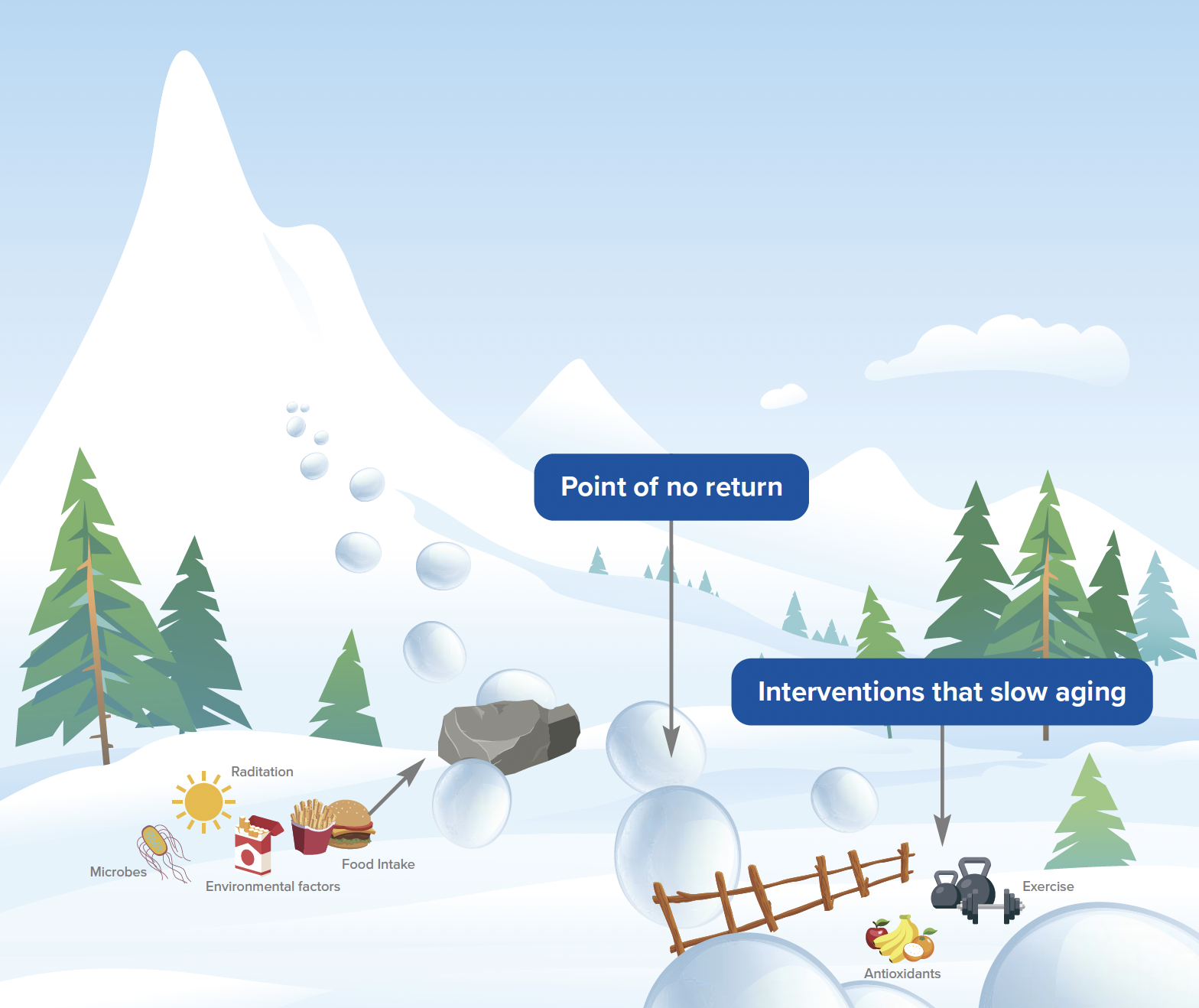Morgan A. Key from Hill’s Pet Nutrition outlines the changes associated with aging pets and how nutrition can help
Aging is a continuous, lifelong process. (1) The aging process can impact dogs’ health, behavior, and care requirements. Approximately 30% to 49% of dogs in the U.S. are ≥ 7 years old. (2, 3) Aging impacts individual animals differently due to differences in breed, frame size, conformation, genetics, and exposure to injuries and disease.
One major contributor to aging is the excessive production of free radicals, also known as reactive oxygen species (ROS). Various studies demonstrate the positive role of antioxidants, including Vitamin C and E, in managing ROS and, thus, the aging process (Figure 1).
Protecting aging pets: Biological mechanisms leading to aging
There are over 300 theories outlining the biological mechanisms leading to aging, with each being placed in their respective categories. (5, 6) A few categorizations of aging theories include programmed, stochastic, biological, and molecular. (7)
The free-radical theory of aging explains the aging phenomena at the molecular level, including the connection between the average life spans of mammals and their basal metabolic rates. (8) The free-radical theory proposes that free radicals produce cell damage and that age-dependent pathologic alterations may, at least in part, be the cumulative result of these changes. (9)
Antioxidants and mitochondrial cofactors
Antioxidants help the body defend itself against the effects of free radicals through a complex network of protective antioxidant compounds. (9) Antioxidants quench or inhibit the reactions caused by free radicals and ultimately prevent or delay cellular damage. The existence of the antioxidant defense mechanism is universal, although there are variations in antioxidant defenses between different species. (10)
In companion animals, the effectiveness of antioxidant-enriched foods is theoretically linked to their ability to arrest or reverse cellular dysfunction produced by excessive free radicals and improve aged mitochondrial function. (11, 12) Specifically, antioxidants significantly improve or slow the decline of learning and memory in aged dogs. (13)
Antioxidants and mitochondrial cofactors have been shown to be beneficial to dogs during the aging process. Vitamin E is lipid soluble and acts to protect cell membranes from oxidative damage. (14) Compounds such as vitamin C and selenium are essential components of the antioxidant enzyme, glutathione peroxidase.
These compounds make up the list of antioxidant key nutritional factors because: 1) they are biologically important, 2) they act synergistically (e.g., vitamin C regenerates vitamin E after it has reacted with a free radical), 3) they are safe, and 4) information regarding inclusion levels in pet foods is publically available. (9) Fruits and vegetables, rich in antioxidants, flavonoids, and carotenoids (5), have been used to enhance diets with the aforementioned benefits.
Decline in physical or mental health for aging pets As pets age, a decline in physical or mental health can be a challenge for owners. The American Kennel Club (AKC) acknowledges that signs of physical, mental, and behavioral change can affect aging. (15) Signs include vision loss, anxiety, increased vocalization, a decline in overall hygiene, inconsistent sleep cycle, irritability, confusion/disorientation, hearing loss, mobility issues, weight change, muscle mass loss, decreased coat quality, and/or incontinence. (15, 16)
These common symptoms associated with aging often are insidious and unobserved. As a result, nutritional adjustments may be delayed or, in some cases, never implemented.
Optimum nutrition for aging pets and animals
Optimum nutrition is essential for aging animals. A recent study completed by Hill’s Pet Nutrition demonstrated this theory. Healthy aging dogs (n=76) were fed a food enriched with antioxidants, fatty acids, and a nutrient blend specific for aging dogs. Findings from monthly owner assessments demonstrated an increased (d 28 P=0.0032, d 56 P=0.0081, and d 84 P= 0.0023) pet affection, stamina, and mental ability. Overall, this showed that nutritional intervention improved dogs’ stamina, bond to owners, cognitive function, allowed for a more independent dog, and overall improved quality of life in only 30 days. (17)
As dogs have continued to evolve with humans, so too must nutrition. Dogs live longer and have become a bigger part of the family. There have been several theories on what causes aging, one being the free radical theory. When dogs are fed a balanced nutrition supplemented with antioxidants, cell damage caused by excessive free radicals can be slowed. Special studies including our unique research support this theory, showing significant improvement in affection, stamina, and mental ability in aged dogs.
References
- Harvey, N. D. (2021). How Old Is My Dog? Identification of Rational Age Groupings in Pet Dogs Based Upon Normative Age-Linked Processes. Front. Vet. Sci., 8 (Animal Behavior and Welfare).
- AVMA. (2007). Total pet ownership and pet population. In: US pet ownership and demographics sourcebook. Schaumburg, Ill: 6–23.
- P&G. 2011. Pet care consumer survey. Mason, Ohio: The Iams Company.
- Booth, L. N., & Brunet, A. (2016). The Aging Epigenome. Molecular cell, 62(5), 728–744.
- da Costa JP, et al. (2016). A synopsis on aging: theories, mechanisms and future prospects. Ageing Res Rev 2016; 29:90-112.
- Medvedev ZA. (1990). An attempt at a rational classification of theories of ageing. Biol Rev Camb Philos Soc.;65:375–398.
- Suresh I.S. Rattan (2006) Theories of biological aging: Genes, proteins, and free radicals, Free Radical Research, 40:12, 1230-1238.
- Harman D (1981): The aging process. Proc Natl Acad Sci USA 1981;78:7124-7128.
- Hand, M. S., et al. (2022). Small Animal Clinical Nutrition (5th ed., pp. 273–279). Mark Morris Institute. (Original work published 1983)
- Nimse, S. B., & Pal, D. (2015). Free radicals, natural antioxidants, and their reaction mechanisms. RSC advances, 5(35), 27986-28006.
- Milgram, N.W., et al. (2005). Learning ability in aged beagle dogs is preserved by behavioral enrichment and dietary fortification: a 2-year longitudinal study. Neurobiol. Aging 26, 77–90.
- Zicker, S.C., (2005). Cognitive and behavioral assessment in dogs and pet food market applications. Prog. Neuropsychopharmacol. Biol. Psychiat. 29, 455–459.
- Head, E., et al. (2008). Oxidative stress, aging, and central nervous system disease in the canine model of human brain aging. The Veterinary clinics of North America. Small animal practice, 38(1), 167–vi.
- Hall, J. A., et al.(2006). Dietary antioxidants and behavioral enrichment enhance neutrophil phagocytosis in geriatric Beagles. Veterinary immunology and immunopathology, 113(1-2), 224–233.
- Reisen, J. (2022). “Aging in Dogs: Physical and Mental Signs That Your Dog Is Getting Older.” American Kennel Club.
- Hill’s Pet. (2023). Signs that Your Dog is Aging and What You Can Do | Hill’s Pet Nutrition.
- Key, M. A., et al. (2023). Observational Canine Aging

This work is licensed under Creative Commons Attribution-NonCommercial-NoDerivatives 4.0 International.



